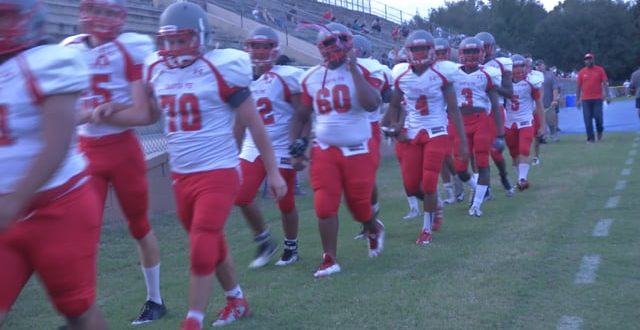GAINESVILLE, Fla. – The NFL and NCAA’s concussion crisis and player safety initiatives have been well-chronicled, praised, criticized and debated.
However, the issue of player safety at the high school level has often been ignored, although that’s changing.
“Youth exposure to repetitive head impacts in tackle football may reduce one’s resiliency to brain diseases later in life, including, but not limited to, CTE,” said Ann McKee, director of Boston University’s CTE Center and an author of a study, in a story by USA Today. “It makes common sense that children, whose brains are rapidly developing, should not be hitting their heads hundreds of times per season.”
According to a CNN story, in late September, Dylan Thomas, a linebacker at Pike County (Ga.) High School, suffered what was initially thought to be a leg injury. While talking to the trainers on the sideline, he fell off the bench before briefly waking up and saying, “I can’t feel my body.” Thomas died two days later from a head injury.
Gainesville High School Athletic Director Cindy Boulware said the increased popularity of high school athletics is one reason stories such as Thomas’ seems more prevalent.
“Injuries are unavoidable, but I think with the awareness that’s being brought to the game about proper tackling and equipment that is being introduced into the game right now, I think the game is taking the necessary steps to make it as safe – not only as enjoyable, but as safe as it could possibly be,” said Dock Pollard, Santa Fe High School head coach and former Florida Gators defensive back.
Here are some of the ways the Florida High School Athletic Association and local high schools are trying to improve player safety.
Education
While it would be impossible to completely eliminate dangerous plays from the game and have the game still resemble football, the FHSAA has focused on educating athletes, parents and coaches on the dangers of the sport and the best practices for minimizing injuries.
Every state requires that student-athletes watch “Concussion in Sports – What You Need to Know,” a 45-minute long presentation on head injuries every year, Boulware said. Once completed, athletes receive a certificate. All student-athletes are required to have the certificate, but some coaches opt to have their entire teams watch the video at once for greater efficiency.
Coaches have to go through USA Football’s “Heads Up Football” program and become certified, Pollard said. The training program involves coaches from around the country and takes 4-5 hours to complete. The program features film work and guest speakers, and then the coaches take to the field to walk through the tackling techniques that they will pass on to their players.
While the FHSAA has required student-athletes to submit a consent form for a while, there’s now a whole page on concussions that parents and students are required to read and sign.
These programs and policies are designed to teach players and coaches that it’s not just concussions that they need to be worried about when playing football, Boulware said. Even if someone never suffers an official concussion, the repetition of hits to the head over the years can still lead to brain damage, such as CTE.
Procedures and Protocol
Like the NFL and NCAA, the FHSAA requires that teams start summer practices with non-contact practices and gradually build toward full-contact practices, Boulware said. There are also limits on the amount of contact practices during the season.
Pollard warned, however, that eliminating too much physicality from practice could make a team unprepared to play on Friday nights and leave players susceptible to other injuries. The challenge is finding the right balance between getting players ready to play physically without putting them at unnecessary risks in practice.
To help reach this balance, he frequently uses tackling dummies and sleds to work on tackling.
USA Football’s “Heads Up Football” campaign encourages a rugby-style of tackling known as Hawk Tackling, named after the team that popularized the style, the Seattle Seahawks, Pollard said.
“It’s definitely a part of the game as much as field goals and touchdowns, teaching head out of contact as much as possible,” he said.
Tackling with the head up has always been taught by coaches, he said. It’s just emphasized more now.
Concussions are inevitable in a violent sport like football, however, and schools have plans in place to address them when they do happen.
Each school in the area is assigned a certified athletic trainer every year by the University of Florida’s Orthopaedics and Sports Medicine Institute, Boulware said. This year, GHS’s athletic trainer is Treven Gezella.
“We’re just lucky to have him because some of the stuff they showed us in the concussion video, some schools don’t have an athletic trainer, and they don’t have a team doctor,” Boulware said. “My knowledge of coaches and what some of their backgrounds are as far as taking classes, I wouldn’t trust just a regular coach with a head injury.”
One of the biggest changes in how concussions are now treated at the high school level is that there are no longer different degrees of concussions, Gezella said. If a player complains of having a headache or exhibits any symptoms of a concussion, he is removed from the game and enters concussion protocol.
However, some athletes might be tempted to hide their concussions in order to continue playing. Gezella said personality changes are a major alarm.
“If they’re not talking to anyone, and they’re usually talking and getting notes from the coach, and they’re just off by themselves not feeling right, and you can tell a little bit, that’s when I go over there, and I can make the call and go into a further assessment,” he said.
Once a player is identified as suffering from concussion symptoms, Gezella notifies the coach and removes him from the game, he said. If a player is uncooperative, he can have the equipment staff take his helmet away.
The school then follows the Centers for Disease Control and Prevention’s recommendations, Boulware said. After being removed from the game and evaluated by a medical professional, parents are informed. A physician must then fill out a form clearing the athlete to return to activity before return-to-play protocol is initiated.
In the FHSAA, return-to-play protocol is a six-step process. In order, the stages are: rest, light aerobic exercise, sport-specific exercise, non-contact training, full-contact practice and return to full activity. To move from one stage to the next, an athlete must be symptom-free for 24 hours.
“There’s a lot more research out there, and then they found out that 70 percent of the concussions that do occur in high schools are from collisions,” Boulware said. “So, if you can do some things to eliminate that 70 percent of the collisions that are occurring, then it’s going to cut down on the concussions.
Future
Will tackle football exist in 30 or 40 years? It’s a legitimate question. With all of the CTE research coming out, lawsuits being filed against the NFL and NCAA and growing concerns among parents, will the tackle game be scrapped in favor of flag football? Or, if the tackle version of the game still exists, will it look anything like it does now?
While some might be outraged at the NFL’s new leading-with-the-helmet rule and the NCAA’s targeting rule, Gezella said he thinks the rules should make their way to the high school game.
However, while Pollard understands that the intent of the rule is to promote player safety, he said ejecting a player for what in most instances is a non-egregious hit is unfair. They work hard in practice all week, only to have their game cut short because a receiver ducked at the last moment. A 15-yard penalty is sufficient, he said, as a personal foul penalty typically results in a coach removing the player from the game.
He said the issue is further complicated by the high-stakes nature of modern football. High schools and colleges have ramped up their investment in football, and coaches are under pressure to win big.
“[An ejection] could be the difference between a coach keeping his job and losing his job,” he said.
In high school, two personal fouls equal an ejection. Pollard said he thinks that is fairer than an automatic ejection for targeting.
Despite growing concerns from parents and doctors, the game is safer now than it was 10-20 years ago, he said.
Pollard said kids should play football because of the valuable life lessons it teaches.
Furthermore, Gezella pointed out that there’s a risk of bodily harm in many things people do on a regular basis. People have to decide for themselves what risks they’re willing to take.
“We’re at a crossroads here in the game of football, but I think it will be figured out before too long,” Pollard said.
 ESPN 98.1 FM – 850 AM WRUF ESPN 98.1 FM – 850 AM WRUF
ESPN 98.1 FM – 850 AM WRUF ESPN 98.1 FM – 850 AM WRUF




